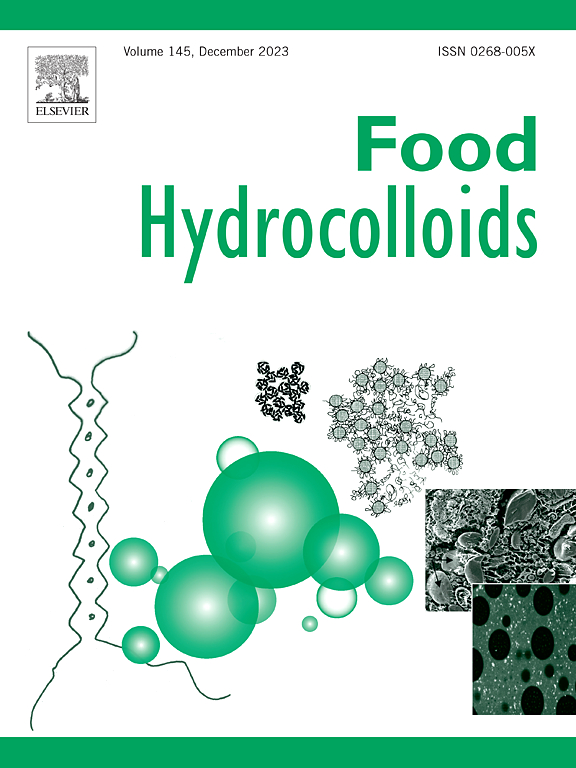Unravelling the multi-scale structure of cell walls from edible seaweed species and the impact of processing treatments
IF 11
1区 农林科学
Q1 CHEMISTRY, APPLIED
引用次数: 0
Abstract
A sequential protocol combining solvent and mechanical treatments, originally designed for land plants, was adapted to concentrate the cell walls of two edible seaweed species, Ulva lacinulata and Porphyra dioica (Nori). However, complete isolation of the cell walls without altering their natural structure was challenging due to strong interactions between polysaccharides and other components, such as proteins. Instead, the process concentrated the cell walls, resulting in polysaccharide contents of 61–63 %. In Ulva, cellulose was identified as the main structural component, while in Nori, porphyrans constituted the semi-crystalline, microfibrillar backbone, closely resembling cellulose in arrangement. These structural variations affected how the cell walls responded to mechanical (ultrasounds, US) and thermal (steam cooking) treatments, as evidenced by the advanced structural characterisation of the samples, combining Small Angle X-ray Scattering (SAXS) and X-ray diffraction (XRD) with microscopy and monosaccharide analyses. In Ulva, steam cooking preserved cell wall integrity while releasing intracellular components, whereas US disrupted the crystalline cellulose structure, causing significant cell wall breakdown and the release of proteins and polysaccharides. For Nori, steam cooking promoted protein release and the migration of some polysaccharides into the extracellular matrix, while US altered the crystalline structure of porphyrans but preserved cellular integrity due to the dense, gel-like extracellular matrix. These results highlight the importance of the composition and structure of the cell wall in seaweeds in determining their mechanical integrity and transformation responses.

揭示食用海藻细胞壁的多尺度结构及其加工处理的影响
最初为陆地植物设计的溶剂和机械处理相结合的顺序方案,被用于浓缩两种可食用海藻的细胞壁,Ulva lacinulata和Porphyra dioica(紫菜)。然而,由于多糖与其他成分(如蛋白质)之间的强烈相互作用,在不改变其自然结构的情况下完全分离细胞壁是具有挑战性的。相反,该过程浓缩了细胞壁,使多糖含量达到61 - 63%。在紫菜中,纤维素被确定为主要结构成分,而在紫菜中,卟啉构成半结晶的微纤维骨架,在排列上与纤维素非常相似。这些结构变化影响了细胞壁对机械(超声波,US)和热(蒸汽蒸煮)处理的反应,正如样品的高级结构表征所证明的那样,结合小角x射线散射(SAXS)和x射线衍射(XRD)与显微镜和单糖分析。在Ulva中,蒸汽蒸煮在释放细胞内成分的同时保持了细胞壁的完整性,而US破坏了结晶纤维素结构,导致细胞壁的严重破坏和蛋白质和多糖的释放。对于紫菜,蒸煮促进了蛋白质的释放和一些多糖向细胞外基质的迁移,而US改变了卟啉的晶体结构,但由于致密的凝胶状细胞外基质,保留了细胞的完整性。这些结果突出了海藻细胞壁的组成和结构在决定其机械完整性和转化响应中的重要性。
本文章由计算机程序翻译,如有差异,请以英文原文为准。
求助全文
约1分钟内获得全文
求助全文
来源期刊

Food Hydrocolloids
工程技术-食品科技
CiteScore
19.90
自引率
14.00%
发文量
871
审稿时长
37 days
期刊介绍:
Food Hydrocolloids publishes original and innovative research focused on the characterization, functional properties, and applications of hydrocolloid materials used in food products. These hydrocolloids, defined as polysaccharides and proteins of commercial importance, are added to control aspects such as texture, stability, rheology, and sensory properties. The research's primary emphasis should be on the hydrocolloids themselves, with thorough descriptions of their source, nature, and physicochemical characteristics. Manuscripts are expected to clearly outline specific aims and objectives, include a fundamental discussion of research findings at the molecular level, and address the significance of the results. Studies on hydrocolloids in complex formulations should concentrate on their overall properties and mechanisms of action, while simple formulation development studies may not be considered for publication.
The main areas of interest are:
-Chemical and physicochemical characterisation
Thermal properties including glass transitions and conformational changes-
Rheological properties including viscosity, viscoelastic properties and gelation behaviour-
The influence on organoleptic properties-
Interfacial properties including stabilisation of dispersions, emulsions and foams-
Film forming properties with application to edible films and active packaging-
Encapsulation and controlled release of active compounds-
The influence on health including their role as dietary fibre-
Manipulation of hydrocolloid structure and functionality through chemical, biochemical and physical processes-
New hydrocolloids and hydrocolloid sources of commercial potential.
The Journal also publishes Review articles that provide an overview of the latest developments in topics of specific interest to researchers in this field of activity.
 求助内容:
求助内容: 应助结果提醒方式:
应助结果提醒方式:


